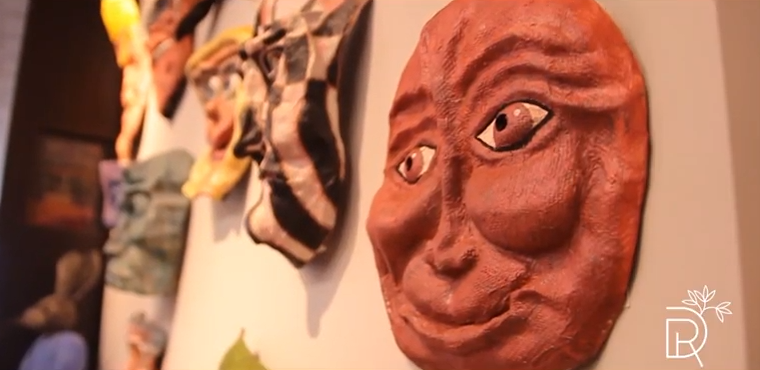
Tom Thomson spent many of his summers in Algonquin Park and other areas in Northern Ontario. The landscape inspired many of his paintings.
These ‘canoe’ plants are some of the many native plants that he would have seen on his travels. Often there would be only small or subtle blooming flowers visible. The textures of the different foliage and the play of light on the many different leaf shapes would offer a different kind of beauty.
To learn more about these native Ontario plants, read on for descriptions of some of the plants in the canoe.
As the OPEN Team, the four cultural institutions have been working together to enhance programming and service delivery to benefit our shared public. Initiatives have included the launch of the OPEN card program for local residents, the development and promotion of a pollinator corridor utilizing some of our outdoor spaces, the facilitation of a Pollinator Symposium, and the coordination of a community lens project focussing on working with those experiencing housing challenges to assist them in sharing their stories and vision. The OPEN Team is committed to partnering on projects and activities that are important to our community and which support our values of inclusiveness, creativity, and caring. Interested in finding out more about our programs and services? It is time for you to visit us either in person or online.
Public art gallery and national attraction with a collection of over 2600 contemporary and historical artworks. Presenting exhibitions, events, education, and research.
Tom Thomson (1877-1917) is an iconic Canadian landscape painter who is regarded as one of the most influential artists of the 20th century. Thomson is buried in Leith, Ontario (where he grew up) after he died in a tragic accident on Canoe Lake, Algonquin Park, at the age of 39. The actual cause of his death remains an unsolved mystery. Founded in 1967, the Tom Thomson Art Gallery is custodian of the fourth largest public collection of Tom Thomson’s artworks in the world and it is the only public art gallery to be built through the support and contributions of Thomson’s family and friends.
Tom Thomson, the Group of Seven, and their contemporaries were just the start; the expanding collection and changing exhibitions continue to explore the results of their enduring influence on living artists as they make their own comment on the Canadian landscape and social justice issues today.
The Owen Sound & North Grey Union Public Library
is a renovated Carnegie building dating from 1914 with a 1970s addition. This modern facility boasts free WI-FI and public computers, library programs, family fun activities, board games and puzzles, browsable books and magazines, local events and community notice boards, bicycle maintenance station, genealogical resources and local history materials, photocopying and scanning services. Don’t forget to check out the hundreds of thousands of items available to you as digital content, including books, magazines, movies, courses, and more. We are focused on helping you with your educational, employment and entertainment needs. Visit us in person at 824 1st Avenue West or online at our virtual branch at www.osngupl.ca.
Community Waterfront Heritage Centre
The Community Waterfront Heritage Centre is a non-profit organization that celebrates and preserves Owen Sound’s heritage on the waterfront, focusing on the marine, rail, and industrial history of the city and surrounding communities. It aims to provide a fun and educational experience to connect our visitors' imagination to our collective history.
Billy Bishop Museum is a non-profit organization committed to preserving local history, including the childhood home of Victoria Cross recipient William Avery “Billy” Bishop. The Museum seeks to engage our community by connecting local stories to the Canadian war experience and broader currents of global history.
Ontario Flora is a social enterprise that offers a native plant nursery, landscape design, ecosystem restoration, and community greening services. We bring people and nature together, and we support and create greening initiatives with wild plants.
Tom’s Portage Plants
1. Bloodroot ,( Sanguinaria canadensis)
The single bloodroot leaf and flower each rise on a separate stem, and at first the leaf completely enwraps the flower bud. The clear, white, many-petaled blossom may open before the leaf has completely unwrapped, rising slightly above the leaf to a height of 6-10 in. Leaves, which are large, round and deeply cleft, eventually reach a height of 12-24 in. On a smooth stalk a solitary white flower, with a golden-orange center, grows beside a lobed basal leaf that often curls around the stalk. Roots and stem with acrid red-orange juice.
This fragile spring flower develops and rises from the center of its curled leaf, opening in full sun, and closing at night. Like most members of the Poppy Family, it lasts for a relatively short time. The red juice from the underground stem was used by Native Americans as a dye for baskets, clothing, and war paint, as well as for insect repellent. The generic name, from the Latin sanguinarius, means "bleeding."
Bloom Color: White
Bloom Time: Mar , Apr
Native Distribution: E. Que. to Man., s. to FL, AL & TX
Native Habitat: Rich, deciduous, upland & floodplain woods
Native Distribution: E. Que. to Man., s. to FL, AL & TX
Native Habitat: Rich, deciduous, upland & floodplain woods
Insects:
Height: 15 cm (6 in) to 30 cm (12 in)
Flowers: white
Blooming period: early spring
Exposure: partial shade to shade
Soil: regular to moist
Specialist pollinator interactions: larval host for tufted apple bud moth
One of the earliest spring flowers to appear, bloodroot’s charming white flowers don’t last for long (just a day or two), but they are a welcome harbinger of spring. The foliage of this groundcover is also attractive, curled around the stem at first, then unfurling into large, saucer-shaped, scalloped leaves. During the typically dry days of late summer (and sometimes earlier), the plant will go dormant if not watered. Although the flowers are nectarless, bees, flies and beetles visit for pollen, and ants disperse the seeds (and eat the elaiosome).It requires humus-rich soil.
2. False Solomon’s seal (Maianthemum racemosum, aka Smilacina racemosa)
Height: 30 cm (12 in) to 60 cm (24 in)
Flowers: white
Blooming period: late spring to early summer
Exposure: partial sun to shade
Soil: regular
Specialist pollinator interactions: larval host for white triangle tortrix moth
Easy to grow in a wide variety of soil conditions, and from partial sun to shade, this plant spreads well to create groundcovering colonies.It produces masses of airy white flowers from late spring through early summer, held at the end of arching stalks (the stalks sometimes zig zag).The clusters of red berries, in summer and fall, are also an attractive feature.Bees collect the pollen, flies and beetles feed on the pollen, and butterflies and moths feed on the nectar.
3. Wild geranium (Geranium maculatum)
Height: .3 m (1 ft) to .6 m (2 ft)
Flowers: pink to purple
Blooming period: mid-spring
Exposure: partial sun to shade
Soil: regular
Specialist pollinator interactions: specialist bee: Andrena distans; larval host for bridled arches, geranium budworm moth, tobacco budworm moth, omnivorous leafroller moth, white-marked tussock moth; Pachyschelus purpureus beetle
Good combinations: foamflower, false Solomon’s seal, Solomon’s seal
For masses of pink to purple flowers in the woodland garden, wild geranium is a reliably colourful performer.You can deadhead it to encourage more blooming.Dark lines on the flowers serve as nectar guides for bees, which also collect pollen from the plant.Flies and butterflies are also attracted to the flowers.The divided leaves are ornamental throughout the summer, as are the beaked seed capsules, which curl upwards to release their seed.It requires humus-rich soil.
4. Sweetgrass. (Hierochloe odorata)
“In some Native languages the term for plants translates to “those who take care of us.”
― Robin Wall Kimmerer, Braiding Sweetgrass
Vanilla Grass or Sweet Grass is an erect, slender, sweet-smelling grass, usually 12-20 in. tall., with small seedheads bearing broad, bronze-colored spikelets. The grass spreads by creeping rhizomes which send up few to several leafy shoots. This is a perennial.
The most common use of sweet grass is by the indigenous people of Canada and the United States. It is used for basket making, its aroma, and smudging. Typically, the sweet grass is braided, dried, and then burned at the beginning of praying, smudging, and purifying ceremonies to attract positive energy.
The flat, bright green leaves can grow up to half a meter long or more, and have a distinctively reddish colour at their base. The flowers are small and greenish, and grow in branching clusters at the top of slender, upright stalks. The seeds are small and often infertile, and rarely germinate to create new plants. Sweetgrass’s most common means of reproduction comes from its creeping, underground stems. These stems, known as rhizomes, grow horizontally under the earth, creating dense patches of grass that can be manually divided up to produce new plants.
Many Indigenous experts affirm that continuous harvesting of sweetgrass helps to maintain the patches. If the sweetgrass meadows are neglected they will gradually disappear, to be replaced by other species of grasses, herbs and shrubs. Some people traditionally burn over their sweetgrass meadows every few years as a way of renewing them and enhancing their productivity.
5. Ostrich Fern (Matteuccia struthiopteris)
The ostrich fern, also known as fiddlehead fern, is so-named because its large leaves resemble ostrich plumes. In Canada, it occurs in parts of all provinces and territories, most abundantly in New Brunswick, southern Québec and southern Ontario, often in flood plains or near rivers or streams. It also occurs in the United States, Japan, China, Siberia, west to Scandinavia, Belgium, France, and parts of the Alps.
This elegant plant grows to a height of about a metre, occasionally 2 metres, in clumps sometimes exceeding a metre in width. The leaves are of 2 types, some large and "ferny" (highly divided), others much smaller and narrower and bearing small spore cases (ferns reproduce by tiny one-celled spores, not seeds).
Uses: Edible - this is the preferred species to eat. However, it should only be eaten in moderation as all ferns contain varying amounts of carcinogenic compounds.
Size: Up to about 10 feet tall.
Distribution:
Canada: NB , NL , NS , ON , PE
Native Distribution: Nf. to s. AK, s. to n. VA, MO, SD & s. B.C.
Native Habitat: Swamps; bottomland woods & thickets
Light Requirement: Part Shade , Shade
Soil Moisture: Moist
Soil Description: Cool, wet, sandy soils.
Ostrich fern can become aggressive and should not be used in small spaces.
6. Round Leafed Ragwort, (Packera obovata)
Round leaved Ragwort, also called Golden Groundsel, is a small perennial that blooms in May and June in our area. Because it blooms so early it supports early emerging pollinating insects.
Size: 1-2 feet
Distribution:
Canada: NB , NL , NS , ON , PE
Native Habitat: Swamps; bottomland woods & thickets
Light Requirement: Sun, Part Shade
Soil Moisture: Medium
Soil Description: Rich wooded banks and limestone soils.
7. Mountain Holly, (Ilex mucronata)
Mountain holly, also known as Catberry, is a small deciduous shrub – the only native holly in eastern North America. It has small red berries in late summer.
Size: up to 10-12 feet
Distribution:
Canada: NB , NL , NS , ON , PE , QC
Native Habitat: Swamps; Marsh, Bog or Fen
Light Requirement: Sun, Part Shade
Soil Moisture: Moist or wet
Soil Description: Sand, loam or clay – slightly acidic
8. Black Chokeberry, (Aronia melanocarpa)
Black Chokeberry is a native deciduous shrub that grows up to about 6 feet tall. It blooms in May or June and produces black berries that birds love – and people enjoy them too.
Size: up to 6 ft
Distribution:
Canada: NB , NS , PE , QC
Native Habitat: Lowlands, bogs, dunes, bluffs
Light Requirement: Sun, Part Shade
Soil Moisture: Moist or wet
Soil Description: Moist acid soils
9. Common Yarrow, (Achillea millefolium)
Common White Yarrow is seen in our area. It grows in fields and along roadsides, and can tolerate some shade. It is very easy to grow, blooms throughout the summer and the ferny foliage is part of its appeal. It supports a variety of pollinating insects throughout the summer.
Size: up to 3 ft
Distribution:
Canada: AB , BC , MB , NB , NL , NS , NT , NU , ON , PE , QC , SK , YT
Native Habitat: adaptable to many sites, prefers dryer areas
Light Requirement: Sun, Part Shade
Soil Moisture: Dry
Soil Description: Most common soils
10. Pearly Everlasting, (Anaphalis margaritaceae)
This is another plant common to our area. It has small white and yellow daisy-like flowers held in a clump and soft light grey foliage. It blooms in late summer. It is very attractive to pollinating insects and is the larval host for the American Painted Lady butterfly.
Size: up to 3 ft
Distribution:
Canada: AB , BC , MB , NB , NL , NS , NT , ON , PE , QC , SK , YT
Native Habitat: Dry prairies; open woods; roadsides; waste places
Light Requirement: Sun, Part Shade
Soil Moisture: Dry.
Soil Description: Sandy or gravelly soils



